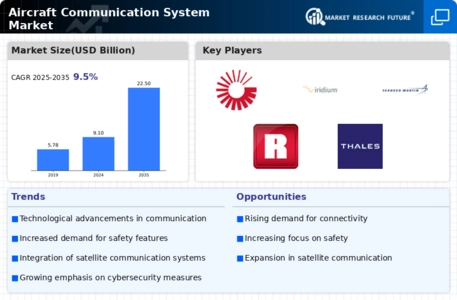Market Trends
Key Emerging Trends in the Aircraft Communication System Market
The aircraft communication system market is witnessing significant growth and transformation, driven by advancements in communication technologies, increasing air traffic, and the need for seamless connectivity and information exchange in aviation operations. One notable trend in the aircraft communication system market is the shift towards digital and broadband communication solutions to meet the growing demand for high-speed data connectivity, voice communication, and multimedia services onboard aircraft. Digital communication systems such as satellite-based broadband internet, air-to-ground (ATG) networks, and next-generation data link technologies enable passengers, pilots, and ground personnel to communicate and exchange data in real-time, enhancing operational efficiency, passenger experience, and safety in air travel.
Moreover, there is a growing emphasis on the integration of communication, navigation, and surveillance (CNS) technologies to enable seamless and integrated air traffic management (ATM) operations in congested and complex airspace environments. Integrated CNS systems combine various communication technologies, including voice, data, and automatic dependent surveillance-broadcast (ADS-B), to provide comprehensive situational awareness and communication capabilities for air traffic controllers, pilots, and unmanned aerial systems (UAS). These integrated systems enable more efficient airspace utilization, optimized flight routing, and enhanced safety through improved coordination and information sharing among airspace users.
Additionally, the aircraft communication system market is witnessing increasing adoption of satellite communication (SATCOM) solutions to provide global connectivity and coverage for aircraft operating in remote, oceanic, and polar regions where terrestrial communication networks are limited or unavailable. SATCOM systems leverage satellite constellations and ground-based infrastructure to deliver reliable voice and data communication services, internet access, and real-time flight tracking capabilities to aircraft, regardless of their location or flight path. As demand for long-haul and transoceanic flights continues to grow, SATCOM solutions play a crucial role in ensuring connectivity and communication continuity for airlines and passengers worldwide.
Furthermore, there is a growing focus on cybersecurity and data protection in the aircraft communication system market, driven by concerns over the security of airborne communication networks and the risk of cyber threats and attacks. Aircraft communication systems are vulnerable to cyber threats such as hacking, data breaches, and unauthorized access, which could compromise the integrity, confidentiality, and availability of communication services onboard aircraft. To address these concerns, aircraft manufacturers, airlines, and communication system providers are investing in cybersecurity measures such as encryption, authentication, intrusion detection, and network segmentation to safeguard airborne communication networks and protect sensitive data from unauthorized access or tampering.
Another notable trend in the aircraft communication system market is the emergence of new communication technologies and standards to support future air traffic management concepts such as trajectory-based operations, collaborative decision-making, and unmanned aircraft integration. Next-generation communication technologies such as multi-frequency datalink, very high frequency (VHF) digital link mode 3 (VDL-3), and space-based ADS-B enable more efficient and reliable data exchange between aircraft, air traffic control, and other stakeholders in the aviation ecosystem. These technologies support the implementation of advanced ATM concepts, improve airspace capacity, and enhance safety and efficiency in air traffic management operations.









Leave a Comment